Lesson 3 Kanji: �$BBh#32]$N4A;z�(B
 Each large, brush-stroke
image below which shows up as a hypertext link (e.g. has a colored box
around it) is a link to a 1 Megabyte (or less) QuickTime movie of the
character being painted with a brush. Look
here for information on configuring your browser appropriately.
Each large, brush-stroke
image below which shows up as a hypertext link (e.g. has a colored box
around it) is a link to a 1 Megabyte (or less) QuickTime movie of the
character being painted with a brush. Look
here for information on configuring your browser appropriately.
JP NET is grateful to Prof. Saeko Komori for
permission to use the kanji movies at our site. All movie data is
copyright 1995, 1996 by Saeko Komori.
In the following definitions, on (Chinese-based) readings
are represented by katakana, and by capital romaji letters;
kun (native Japanese-based) readings are represented by
hiragana, and by lower-case romaji letters. This is a common
dictionary convention, and does not have any bearing on meaning.
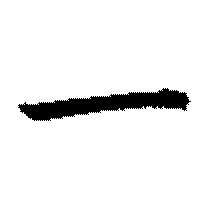
- Printed form:
- �$B0l�(B
- Readings:
- �$B%$%A�(B/�$B%$%C�(B-
- ICHI/IT-
- Meaning:
- one
- Mnemonic:
- A single straight holizontal line.
- Usage Examples:
- �$B0l$P$s�(B (�$B$$$A$P$s�(B) No. 1
- �$B0l%;%s%H�(B (�$B$$$C%;%s%H�(B) one cent
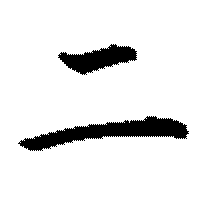
- Printed form:
- �$BFs�(B
- Readings:
- �$B%K�(B
- NI
- Meaning:
- two
- Mnemonic:
- Two horizontal straight lines.
- Usage Examples:
- �$BFs%I%k�(B (�$B$K%I%k�(B) two dollars
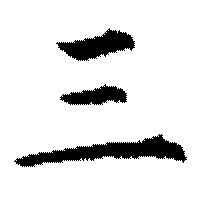
- Printed form:
- �$B;0�(B
- Readings:
- �$B%5%s�(B
- SAN
- Meaning:
- three
- Mnemonic:
- Three straight horizontal lines.
- Usage Examples:
- �$B;0%;%s%H�(B (�$B$5$s%;%s%H�(B) three cents
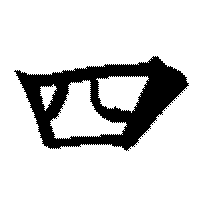
- Printed form:
- �$B;M�(B
- Readings:
- �$B%7�(B/�$B$h�(B-/�$B$h$s�(B
- SHI/yo-/yon
- Meaning:
- four
- Mnemonic:
- Number �$BH,�(B(eight) inside a box. It is cut in half.
[shi] is a reading when conunting 1, 2, 3...
- Usage Examples:
- �$B;M%I%k�(B (�$B$h$s%I%k�(B) four dollars
- �$B;M==;M1_�(B (�$B$h$s$8$e$&$h$($s�(B) 44 yen
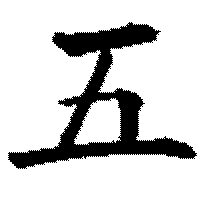
- Printed form:
- �$B8^�(B
- Readings:
- �$B%4�(B
- GO
- Meaning:
- five
- Mnemonic:
- Japanese people count numbers by folding fingers from
thumb to little finger. The original character �$B#X�(B
(Roman numeral 10) symbolizes fingers crossing each other.
- Usage Examples:
- �$BFs==8^%;%s%H�(B (�$B$K$8$e$&$4%;%s�(B) 25 cents
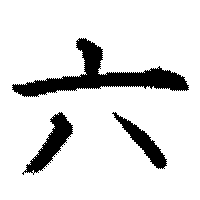
- Printed form:
- �$BO;�(B
- Readings:
- �$B%m%/�(B
- ROKU
- Meaning:
- six
- Mnemonic:
- A picture of a human with six essential parts:
head, two arms, two legs, and main body(invisible).
- Usage Examples:
- �$BO;==1_�(B (�$B$m$/$8$e$&$($s�(B) 60 yen
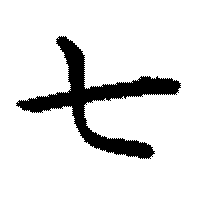
- Printed form:
- �$B<7�(B
- Readings:
- �$B%7%A�(B/�$B$J$J�(B-
- SHICHI/nana-
- Meaning:
- seven
- Mnemonic:
- �$B<7�(B appears in �$B@Z�(B(to cut with sword). The horizontal
line is cut with a vertical line.
- Usage Examples:
- �$B<7%I%k�(B (/�$B$7$A%I%k�(B) seven dollars
- �$B<7==<7�(B (/�$B$J$J$8$e$&$J$J�(B) 77
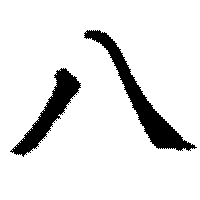
- Printed form:
- �$BH,�(B
- Readings:
- �$B%O%A�(B/�$B%O%C�(B
- HACHI/hat-
- Meaning:
- eight
- Mnemonic:
- The two strokes are almost symmetrical. The number
eight is an easy number to divide.
- Usage Examples:
- �$BH,%I%kH,%;%s%H�(B (/�$B$O$C%;%s%H�(B) 8 dollars and 8 cents

- Printed form:
- �$B6e�(B
- Readings:
- �$B%-%e%&�(B/�$B%/�(B
- KYUU/KU
- Meaning:
- nine
- Mnemonic:
- A picture of an arm bending and stiffening the
muscle. �$B6e�(B has the meaning "draw together" to conclude
the counting from 1 to 10.
- Usage Examples:
- �$B6e%I%k�(B (�$B$-$e$&%I%k�(B) nine dollars
- �$B==6e�(B (/�$B$8$e$&$/�(B) 19
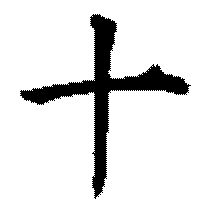
- Printed form:
- �$B==�(B
- Readings:
- �$B%8%e%&�(B/�$B%8%e%C�(B-/�$B%8%C�(B-
- JUU/JUT-/JIT-
- Meaning:
- ten
- Mnemonic:
- A picture of many sticks bundled together with a string.
- Usage Examples:
- �$B;M==%;%s%H�(B (/�$B$h$s$8$C%;%s%H�(B) 40 cents
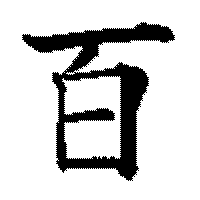
- Printed form:
- �$BI4�(B
- Readings:
- �$B%R%c%/�(B(-�$B%T%c%/�(B/-�$B%S%c%/�(B)
- HYAKU(-PYAKU/-BYAKU)
- Meaning:
- hundred
- Mnemonic:
- The beginning number �$B0l�(B and �$BGr�(B "whilte". Imagine a bowl of rice
containing a hundred of white rice grains.
- Usage Examples:
- �$BI4%I%k�(B (�$B$R$c$/%I%k�(B) 100 dollars
- �$B;0I4�(B (�$B$5$s$S$c$/�(B) 300
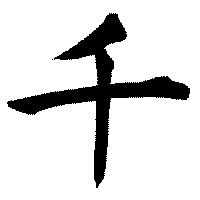
- Printed form:
- �$B@i�(B
- Readings:
- �$B%;%s�(B(-�$B%<%s�(B)
- SEN(-ZEN)
- Meaning:
- thousand
- Mnemonic:
- The combination of �$B0l�(B(symbol of "number") and �$B%$�(B(person).
What is abundant on earth is people.
- Usage Examples:
- �$B@i%I%k�(B (�$B$;$s%I%k�(B) 1000 dollars
- �$B;0@iO;I4�(B (�$B$5$s$<$s$m$C$T$c$/�(B) 3600

- Printed form:
- �$BK|�(B
- Readings:
- �$B%^%s�(B
- MAN
- Meaning:
- ten thousand
- Mnemonic:
- The unit of ten thousand. The character came from an image of
swastika, symbolizing "all" and "all possible directions".
- Usage Examples:
- �$B0lK|�(B (�$B$$$A$^$s�(B) 10000
- �$B8^I4K|�(B (�$B$4$R$c$/$^$s�(B) 5000000
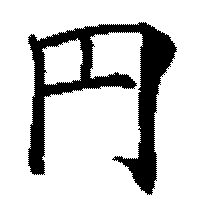
- Printed form:
- �$B1_�(B
- Readings:
- �$B%(%s�(B
- EN
- Meaning:
- yen
- Mnemonic:
- Money machine at a bank.
- Usage Examples:
- �$B@iI41_�(B (�$B$;$s$R$c$/$($s�(B) 1100 yen
- �$B0lK|6e@i1_�(B (�$B$$$A$^$s$-$e$&$;$s$($s�(B) 19000 yen

- Printed form:
- �$B2?�(B
- Readings:
- �$B$J$K�(B/�$B$J$s�(B-
- nani/nan-
- Meaning:
- what; how many
- Mnemonic:
- Two persons �$B%$%$�(B carrying a box �$B8}�(B. The sight draws attention
of people and they ask "What is there inside?"
- Usage Examples:
- �$B2?$G$9$+�(B (�$B$J$s$G$9$+�(B) what is it?
- �$B2?$P$s$G$9$+�(B (�$B$J$s$P$s$G$9$+�(B) what number is it?
 Each large, brush-stroke
image below which shows up as a hypertext link (e.g. has a colored box
around it) is a link to a 1 Megabyte (or less) QuickTime movie of the
character being painted with a brush. Look
here for information on configuring your browser appropriately.
Each large, brush-stroke
image below which shows up as a hypertext link (e.g. has a colored box
around it) is a link to a 1 Megabyte (or less) QuickTime movie of the
character being painted with a brush. Look
here for information on configuring your browser appropriately.













